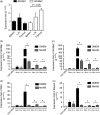System A amino acid transporters regulate glutamine uptake and attenuate antibody-mediated arthritis
- PMID: 26346312
- PMCID: PMC4693895
- DOI: 10.1111/imm.12531
System A amino acid transporters regulate glutamine uptake and attenuate antibody-mediated arthritis
Abstract
Proliferation of rapidly dividing bone marrow-derived cells is strongly dependent on the availability of free glutamine, whose uptake is mediated through different amino acid transporters. The sodium-coupled neutral amino acid transporter (SNAT) family was previously reported to be associated with the development of collagen-induced arthritis in mice. Here, we tested the hypothesis whether impairment of SNAT proteins influences immune cell function and in turn alters arthritis development. The 2-(methylamino)isobutyric acid (MeAIB), a SNAT-specific substrate, was used to modulate the function of SNAT proteins. We demonstrate that glutamine uptake by murine naive lymphocytes, and consequent cell proliferation, is strongly associated with system A transporters. Physiological impairment of SNAT proteins reduced the antibody-initiated effector phase of arthritis, mainly by affecting the levels of circulating monocytes and neutrophils. MeAIB was also shown to affect the proliferation of immortalized cells, through trans-inhibition of SNAT proteins. Based on our observations, we conclude that SNAT proteins regulate the initial stages of lymphocyte activation by regulating glutamine uptake, and that the effector phase of arthritis can be affected by non-metabolized SNAT substrates. Most probably, metabolically active cells within both the adaptive and the innate immune systems are regulated by SNAT proteins and play a role in modifying arthritis development.
Keywords: 2-(methylamino)isobutyric acid; amino acid transporter; arthritis; glutamine; sodium-coupled neutral amino acid transporter.
© 2015 John Wiley & Sons Ltd.
Figures




Similar articles
-
Functional Consequences of Low Activity of Transport System A for Neutral Amino Acids in Human Bone Marrow Mesenchymal Stem Cells.Int J Mol Sci. 2020 Mar 10;21(5):1899. doi: 10.3390/ijms21051899. Int J Mol Sci. 2020. PMID: 32164327 Free PMC article.
-
Expression and function of glutamine transporters SN1 (SNAT3) and SN2 (SNAT5) in retinal Müller cells.Invest Ophthalmol Vis Sci. 2005 Nov;46(11):3980-7. doi: 10.1167/iovs.05-0488. Invest Ophthalmol Vis Sci. 2005. PMID: 16249471
-
Glycine Induces Migration of Microglial BV-2 Cells via SNAT-Mediated Cell Swelling.Cell Physiol Biochem. 2018;50(4):1460-1473. doi: 10.1159/000494646. Epub 2018 Oct 25. Cell Physiol Biochem. 2018. PMID: 30359963
-
Sodium-coupled neutral amino acid (System N/A) transporters of the SLC38 gene family.Pflugers Arch. 2004 Feb;447(5):784-95. doi: 10.1007/s00424-003-1117-9. Epub 2003 Jul 4. Pflugers Arch. 2004. PMID: 12845534 Review.
-
Glutamine transporters in mammalian cells and their functions in physiology and cancer.Biochim Biophys Acta. 2016 Oct;1863(10):2531-9. doi: 10.1016/j.bbamcr.2015.12.017. Epub 2015 Dec 24. Biochim Biophys Acta. 2016. PMID: 26724577 Free PMC article. Review.
Cited by
-
Intervening upregulated SLC7A5 could mitigate inflammatory mediator by mTOR-P70S6K signal in rheumatoid arthritis synoviocytes.Arthritis Res Ther. 2020 Aug 31;22(1):200. doi: 10.1186/s13075-020-02296-8. Arthritis Res Ther. 2020. PMID: 32867828 Free PMC article.
-
[Strong inflammation is essential for expression of articular cartilage-specific citrullinated antigens].Nan Fang Yi Ke Da Xue Xue Bao. 2020 Aug 30;40(8):1081-1089. doi: 10.12122/j.issn.1673-4254.2020.08.03. Nan Fang Yi Ke Da Xue Xue Bao. 2020. PMID: 32895186 Free PMC article. Chinese.
-
T cell metabolism: new insights in systemic lupus erythematosus pathogenesis and therapy.Nat Rev Rheumatol. 2020 Feb;16(2):100-112. doi: 10.1038/s41584-019-0356-x. Epub 2020 Jan 16. Nat Rev Rheumatol. 2020. PMID: 31949287 Review.
-
Glutamine Cooperatively Upregulates Lipopolysaccharide-Induced Nitric Oxide Production in BV2 Microglial Cells through the ERK and Nrf-2/HO-1 Signaling Pathway.Antioxidants (Basel). 2020 Jun 19;9(6):536. doi: 10.3390/antiox9060536. Antioxidants (Basel). 2020. PMID: 32575515 Free PMC article.
-
The spectrum of T cell metabolism in health and disease.Nat Rev Immunol. 2018 Jan;18(1):19-34. doi: 10.1038/nri.2017.99. Epub 2017 Sep 25. Nat Rev Immunol. 2018. PMID: 28944771 Review.
References
-
- Hörig H, Spagnoli GC, Filgueira L, Babst R, Gallati H, Harder F et al Exogenous glutamine requirement in confined to late events of T cell activation. J Cell Biochem 1993; 53:343–51. - PubMed
Publication types
MeSH terms
Substances
LinkOut - more resources
Full Text Sources
Other Literature Sources
Molecular Biology Databases

